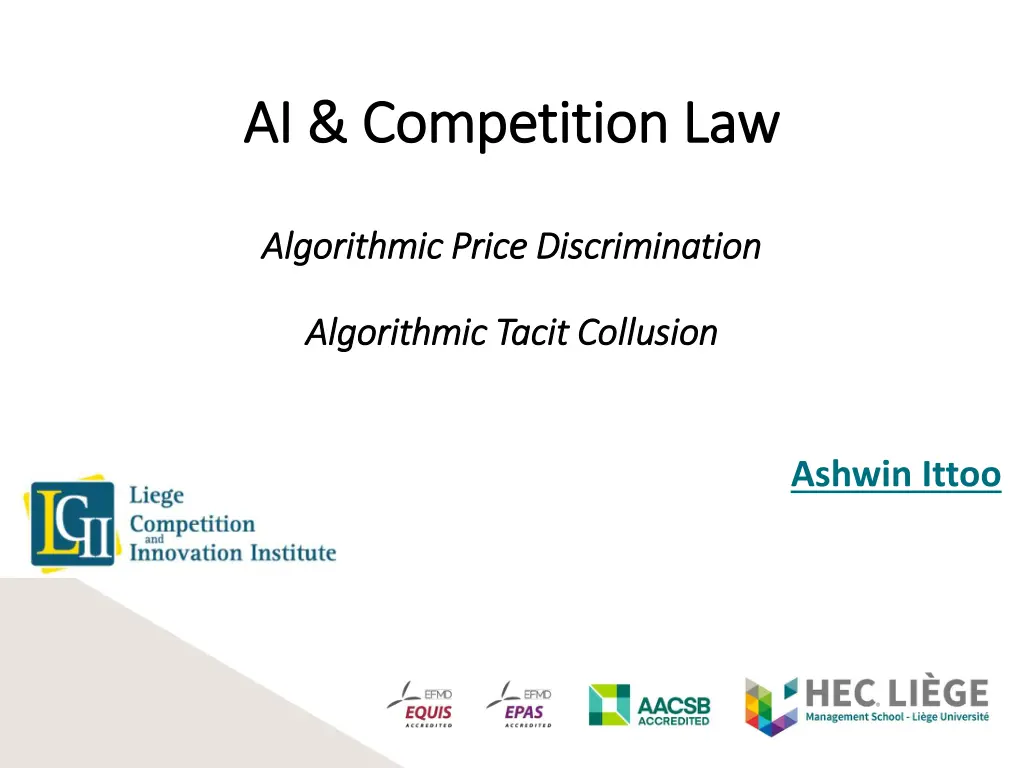
AI, Competition Law, and Price Discrimination Insights
Explore the intersection of AI, competition law, algorithmic price discrimination, and machine learning. Understand concepts like tacit collusion, dominant forms of AI, big data, and the nuances of price discrimination. Dive into how AI enables personalized pricing strategies and the debate around perfect price discrimination in competitive markets.
Download Presentation

Please find below an Image/Link to download the presentation.
The content on the website is provided AS IS for your information and personal use only. It may not be sold, licensed, or shared on other websites without obtaining consent from the author. If you encounter any issues during the download, it is possible that the publisher has removed the file from their server.
You are allowed to download the files provided on this website for personal or commercial use, subject to the condition that they are used lawfully. All files are the property of their respective owners.
The content on the website is provided AS IS for your information and personal use only. It may not be sold, licensed, or shared on other websites without obtaining consent from the author.
E N D
Presentation Transcript
AI & Competition Law AI & Competition Law Algorithmic Price Discrimination Algorithmic Price Discrimination Algorithmic Tacit Collusion Algorithmic Tacit Collusion Ashwin Ittoo
AI & Learning AI & Learning Dominant form of AI Machine/Deep Learning (Deep) Reinforcement Learning Learning from experience/past data
Machine Learning Machine Learning Learning from past data Illustration: Learning to predict Willingness To Pay/WTP {Higher , Lower} price for given product Predicted Variable (Supervised Learning) Predictors
Big Data: 3Vs Big Data: 3Vs AI cannot be decoupled from data Data central for learning Big Data 3 (or 4) Vs
Price Discrimination Price Discrimination Old age phenomenon Familiar manifestations Loyalty discounts Volume or multi-buy discounts Status based discounts (students, old-age pensioners, unemployed)
AI & Price Discrimination AI & Price Discrimination AI for 3rddegree PD Commonplace in marketing Clustering algorithms Segment consumers Similar consumers same groups Similarity Traditional demographic variables Age, Sex, Location, Salary,
AI & PD (cont) Advent of digital platforms Consumers revealing behavioral information breadcrumbs Likes (preferences) Dislikes Sentiments, opinions Purchase patterns AI (machine/deep learning) Reconstruct of digital profile from breadcrumbs Infer WTP
AI & PD (cont) Does AI enable Perfect 1stdegree PD? Data as main impediment Perfect 1stdegree PD requires perfect consumer information Not revealed Consumers acting strategically In (imperfectly) competitive markets, PD conditioned on Search costs (some consumers have no other options than a given vendor) Switching costs (brand preferences) Information hard to obtain or unknown to firms
AI & PD (cont) AI + (available imperfect) information More granular PD than 3rddegree Tends towards, approximates 1stdegree PD Dub & Misra (2018) Classical machine learning, econometrics algorithms Scalable price targeting application 80% expected profit gains from targeted pricing
AI & PD (cont) Is PD always profitable? Yes if sole owner of consumer data Marginal benefits if all firms have access to same data (from brokers) Is PD fair, beneficial to consumers? Loss in customer surplus but Redistributive aspect Includes weaker customers, excluded in uniform pricing
Algorithmic Tacit Collusion AI algorithms increase market transparency Transparency Easier to coordinate price Detect deviations AI increases occurrences of algorithmic tacit collusion?
Algorithmic Tacit Collusion (cont) More sophisticated algorithms than PD Reinforcement/Deep Reinforcement Learning Different data requirements Actions and corresponding rewards of competitors Research in MARL (AI & Game Theory) Agents learn to coordinate Maximize a collective reward Higher than if acted individually
Algorithmic Tacit Collusion (cont) Coordination only 1 component of collusion Credible punishment device as cornerstone of collusion Can agents learn how to establish credible punishment mechanisms? Loss from punishments >> Profits when deviating If one agent deviates, How long will detection take? Will agents collude again? (No plausible in human cartels)
Algorithmic Tacit Collusion (cont) Will AI increase occurences of algorithmic tacit collusion? AI facilitates coordination, Establishment of credible punishment device: open question Current Work with A.Gautier andN.Petit
